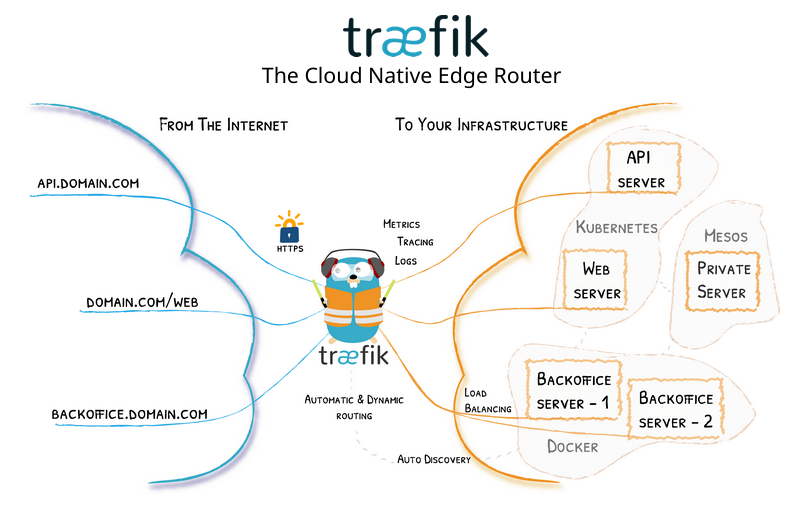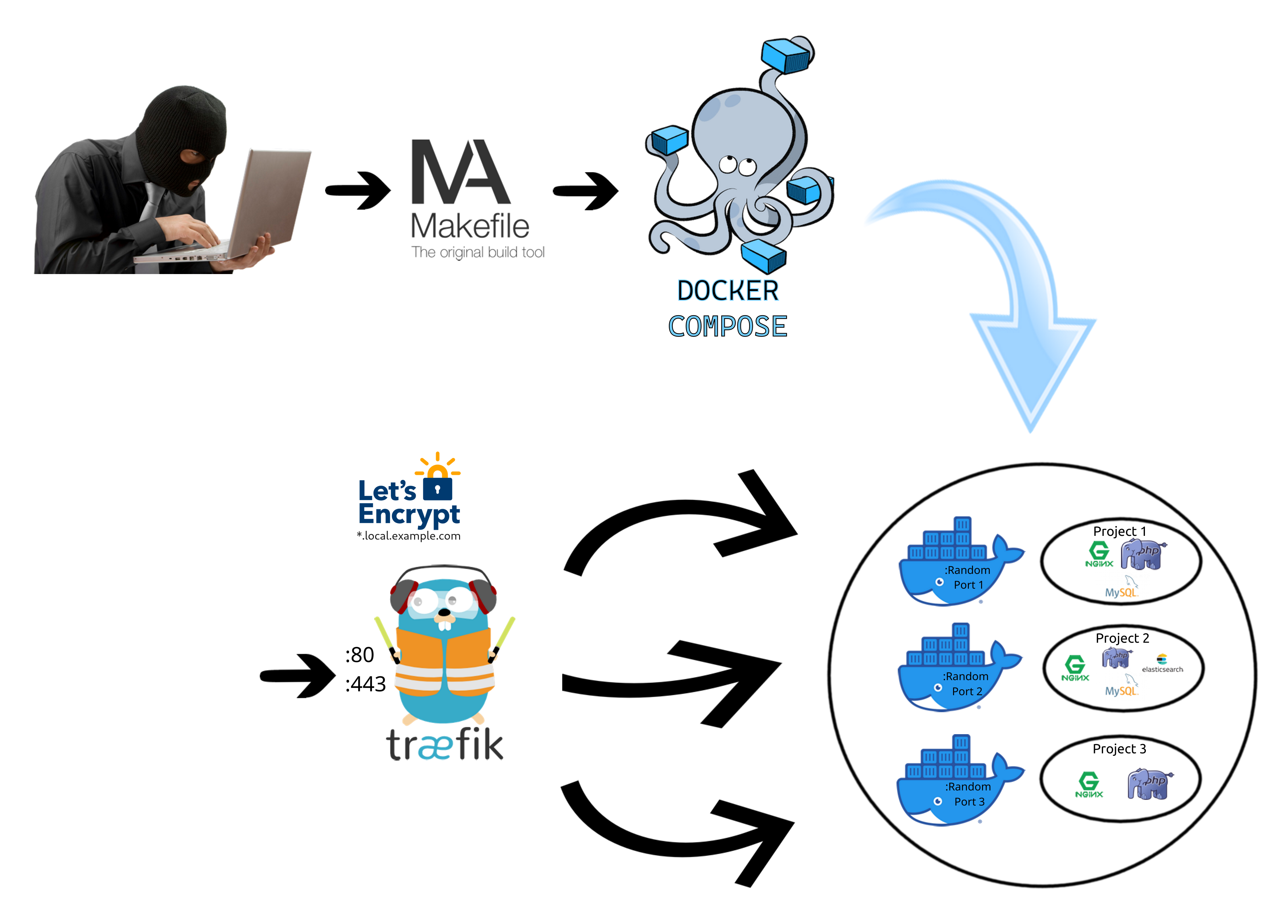Building a Local development Setup for all our projects
docker-compose.yml
version: "3"
services:
# The Application
my_app:
image: bitnami/rails:6
working_dir: /var/www/
volumes:
- ./:/var/www/
- ./resources/docker/vhost.conf:/etc/nginx/conf.d/default.conf:ro
- ./resources/docker/xdebug.ini:/usr/local/etc/php/conf.d/20-xdebug.ini:ro
environment:
- "POSTGRES_USER=postgres"
- "POSTGRES_PASSWD=supersecret"
- "POSTGRES_HOST=db"
- "REDIS_HOST=redis"
labels:
- "traefik.enable=true"
- "traefik.http.middlewares.redirect-2-https.redirectscheme.scheme=https"
- "traefik.http.routers.insecure-myapp.entrypoints=web"
- "traefik.http.routers.insecure-myapp.rule=Host(`myapp.dev.j3j5.uy`)"
- "traefik.http.routers.insecure-myapp.middlewares=redirect-2-https@docker"
- "traefik.http.routers.myapp.entrypoints=web-secure"
- "traefik.http.routers.myapp.rule=Host(`myapp.dev.j3j5.uy`)"
- "traefik.http.routers.myapp.tls=true"
# The Database
database:
image: postgres:alpine3.15
volumes:
- dbdata:/var/lib/postgresql/data
- ./resources/docker/sql-dumps/:/docker-entrypoint-initdb.d/:ro
- ./resources/docker/percona.cnf:/etc/percona-server.conf.d/custom.cnf:ro
environment:
- "POSTGRES_PASSWORD=supersecret"
- "PGDATA=/var/lib/postgresql/data/pgdata"
elastic:
image: docker.elastic.co/elasticsearch/elasticsearch:8.8.1
volumes:
- esdata:/usr/share/elasticsearch/data
- ./resources/docker/jvm.options:/usr/share/elasticsearch/config/jvm.options:ro
environment:
- cluster.name=my-cluster
- node.name=the-node
- bootstrap.memory_lock=true
- discovery.type=single-node
- "ES_JAVA_OPTS=-Xms512m -Xmx512m"
ulimits:
memlock:
soft: -1
hard: -1
# Redis
redis:
image: redis:7-alpine
volumes:
- redisdata:/data
- ./resources/docker/redis.conf:/usr/local/etc/redis/redis.conf:ro
volumes:
dbdata:
redisdata:
pmadata:
esdata:
networks:
default:
external: true
name: gateway
Docker-Compose commands
# To start the containers
docker-compose up -d
# To stop them
docker-compose down
# To delete them
docker-compose rm -vsf
# To tail the logs from the container
docker-compose logs -f database
# To stop the container AND remove the orphaned containers
docker-compose down -v --remove-orphans
# To get a working shell
docker-compose run --rm myapp sh
TOO CUMBERSOME!
HARD TO REMEMBER!
Makefile
container=myapp
container_id=$(shell docker ps --filter "name=$(container)" --format '{{.ID}}')
compose_file=docker-compose.yml
host=$(shell grep -m 1 'rule=Host(`.*`)' $(compose_file) | sed 's/[^`]*`\(.*\)`[^`]""/\1/' )
up:
docker-compose up -d
@echo ""
@echo "You can access the project at: https://$(host)"
@echo ""
.PHONY: up
build:
docker-compose rm -vsf
docker-compose down -v --remove-orphans
docker-compose build
docker-compose up -d
@echo ""
@echo "You can access the project at: https://$(host)"
@echo ""
.PHONY: build
clean:
docker-compose rm -vsf
docker-compose down -v --remove-orphans
.PHONY: clean
down:
docker-compose down --remove-orphans
.PHONY: down
restart:
docker-compose down --remove-orphans
docker-compose up -d
@echo ""
@echo "You can access the project at: https://$(host)"
@echo "DB Admin: https://$(db_admin_host)"
@echo ""
.PHONY: restart
migrate:
docker exec -it $(container_id) php artisan migrate
.PHONY: migrate
migrate-fresh:
docker exec -it $(container_id) php artisan migrate:fresh
.PHONY: migrate-fresh
migrate-rollback:
docker exec -it $(container_id) php artisan migrate:rollback
.PHONY: migrate-rollback
seed:
docker exec -it $(container_id) php artisan db:seed
.PHONY: seed
truncate:
docker exec -it $(container_id) php artisan eb:truncate
.PHONY: truncate
composer-install:
docker exec -it $(container_id) composer install
.PHONY: composer-install
composer-update:
docker exec -it $(container_id) composer update
.PHONY: composer-update
npm:
docker exec -it $(container_id) npm install
.PHONY: npm
npm-dev:
docker exec -it $(container_id) npm run dev
.PHONY: npm-dev
jumpin:
docker exec -it $(container_id) bash
.PHONY: jumpin
test:
docker exec -it $(container_id) php -d pcov.enabled=1 vendor/bin/phpunit
.PHONY: test
larastan:
docker exec -it $(container_id) php vendor/bin/phpstan analyse
.PHONY: larastan
logs:
docker-compose logs -f
.PHONY: logs
queue:
docker exec -it $(container_id) php artisan queue:work
.PHONY: queue
run-ip:
docker inspect -f '{{ .NetworkSettings.Networks.gateway.IPAddress }}' `docker ps --filter "name=eb_app_run" --filter status=running --format "{{.ID}}"`
.PHONY: run-ip

version: "3"
services:
traefik:
image: traefik:v2.5
command: --providers.docker # Enables the web UI and tells Traefik to listen to docker
container_name: global_traefik
restart: "always"
ports:
- "80:80" # Port 80 is used for HTTP trafic
- "443:443" # Port 443 is used for HTTPS trafic
volumes:
# Here is the mount of the traefik config
- ./traefik.toml:/etc/traefik/traefik.toml:ro
- ./tls-info.toml:/etc/traefik/tls-info.toml:ro
# Here is the mount of the local ~/ssl directory
- ./ssl:/etc/traefik/ssl:ro
# The docker socket is mounted for auto-discovery of new services
- /var/run/docker.sock:/var/run/docker.sock:ro
networks:
# Attach the traefik container to the default network (which is the global "gateway" network)
- default
labels:
- "traefik.enable=true"
- "traefik.http.routers.api.entrypoints=web-secure"
- "traefik.http.routers.api.rule=Host(`dashboard.local.j3j5.uy`)"
- "traefik.http.routers.api.service=api@internal"
- "traefik.http.routers.api.middlewares=auth"
- "traefik.http.routers.api.tls=true"
- "traefik.http.middlewares.auth.basicauth.users=admin:$$may1$$aBcN4ABC7$$RY/wKJaBc45aUbBcDubmre0"
# Make the externally created network "gateway" available as network "default"
networks:
default:
external: true
name: gateway
docker-compose.yml
version: '3'
services:
# The Web Server
web:
image: nginx:1.24
volumes:
- ./:/var/www
- ./resources/docker/vhost.conf:/etc/nginx/conf.d/default.conf:ro
depends_on:
- app
restart: "always"
labels:
- "traefik.enable=true"
- "traefik.http.middlewares.redirect-2-https.redirectscheme.scheme=https"
- "traefik.http.routers.insecure.entrypoints=web"
- "traefik.http.routers.insecure.rule=Host(`project.dev.j3j5.uy`)"
- "traefik.http.routers.insecure.middlewares=redirect-2-https@docker"
- "traefik.http.routers.main.entrypoints=web-secure"
- "traefik.http.routers.main.rule=Host(`project.dev.j3j5.uy`)"
- "traefik.http.routers.main.tls=true"
networks:
default:
external: true
name: gateway

